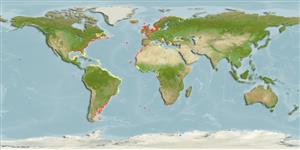Common names from other countries
Classification / Names / Names
ชื่อสามัญ | ชื่อพ้อง | Catalog of Fishes (gen., sp.) | ITIS | CoL | WoRMS
Environment: milieu / climate zone / depth range / distribution range
นิเวศวิทยา
; ระดับความลึก 0 - 49 m (Ref. 104365). Subtropical; 52°N - 36°S, 98°W - 34°W
Western Atlantic: From Gulf of St. Lawrence to Uruguay. Introduced to Eastern Atlantic and the Mediterranean.
Length at first maturity / ขนาด / น้ำหนัก / Age
Maturity: Lm ? range ? - ? cm Max length : 6.5 cm SHL เพศผู้/กระเทย; (Ref. 7882); common length : 4.0 cm SHL เพศผู้/กระเทย; (Ref. 437)
Species' maximum length from the Belgian part of the North Sea (Ref. 7882). Estuarine (Ref. 104365). Found along coasts in fine to muddy sediment. Bores in hard clay, limestone, solidified mud, and pieces of peat and wood (Ref. 7882).
Life cycle and mating behavior
วัยเจริญพันธุ์ | การสืบพันธุ์ | การวางไข่ | เซลสืบพันธ์ของเพศเมีย(ไข่) | ความดกของไข่ | ตัวอ่อน
Members of the class Bivalvia are mostly gonochoric, some are protandric hermaphrodites. Life cycle: Embryos develop into free-swimming trocophore larvae, succeeded by the bivalve veliger, resembling a miniature clam.
Fischer, W., G. Bianchi and W.B. Scott (eds.). 1981. (Ref. 437)
IUCN Red List Status (Ref. 130435)
CITES status (Ref. 108899)
Not Evaluated
Not Evaluated
Human uses
| FishSource |
เครื่องมือ
ข้อมูลเพิ่มเติม
Age/Size
การเจริญเติบโต
Length-weight
Length-length
สัณฐานวิทยา
ตัวอ่อน
อุดมสมบรูณ์
แหล่งที่มาจากอินเตอร์เน็ต
Estimates based on models
Preferred temperature
(Ref.
115969): 8.2 - 23.9, mean 11.2 (based on 510 cells).
Price category
Unknown.
